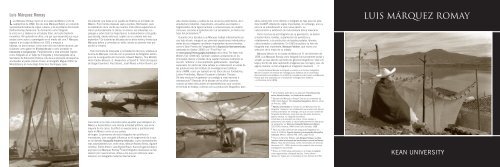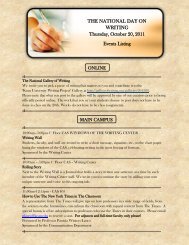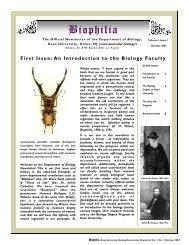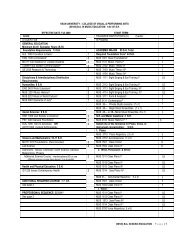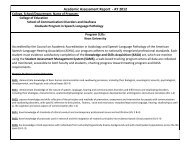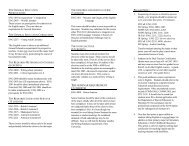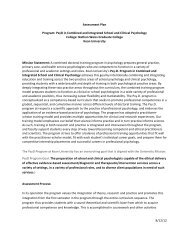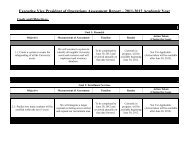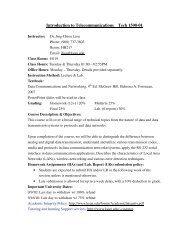Luis Márquez Romay - Kean University
Luis Márquez Romay - Kean University
Luis Márquez Romay - Kean University
Create successful ePaper yourself
Turn your PDF publications into a flip-book with our unique Google optimized e-Paper software.
<strong>Luis</strong> <strong>Márquez</strong> <strong>Romay</strong><br />
uis <strong>Márquez</strong> <strong>Romay</strong> nació en la ciudad de México el 25 de<br />
L septiembre de 1899, hijo de José <strong>Márquez</strong> Ballot, un conocido<br />
representante teatral de origen cubano, y de la poblana Ana Josefa<br />
Delfina <strong>Romay</strong> Zamacona. Su formación como fotógrafo<br />
la inició en La Habana en el Estudio Feliú, de fuerte tradición<br />
romántica. Ahí aprendió el oficio, a la par que desarrolló sus inquietudes<br />
como actor y camarógrafo en el medio del cine. 1 <strong>Márquez</strong><br />
regresó a la ciudad de México en 1921 y empezó a<br />
trabajar, en poco tiempo, como actor del cine silente nacional, participando<br />
como galán en El cristo de oro o como jorobado en<br />
Liberación o Conspiración. Paralelamente a esta actividad ingresó<br />
como fotógrafo en el Taller de Fotografía y Cinematografía de la<br />
Secretaría de Educación Pública. Uno de sus primeros encargos fue<br />
acompañar al padre Canuto Flores, al etnógrafo Miguel Othón de<br />
Mendizábal y al musicólogo Francisco Domínguez para<br />
documentar una fiesta en el pueblo de Chalma en el Estado de<br />
México. Poco tiempo después viajó a Janitzio, Michoacán, para<br />
la celebración de la noche de muertos. Esta última experiencia lo<br />
marcó profundamente: la danza, la música, las artesanías, los<br />
paisajes y sobre todo los trajes típicos lo deslumbraron a tal grado<br />
que decidió, desde entonces, captar con su cámara todo ese<br />
esplendor. 2 Es durante las décadas de los años veinte y treinta que<br />
<strong>Márquez</strong> define y consolida un estilo, siendo su período más productivo<br />
y creativo.<br />
Este momento de búsqueda y consolidación técnica y estética en<br />
la obra de <strong>Márquez</strong> coincide con la presencia de fotógrafos extranjeros<br />
de la vanguardia del momento: Edward Weston, Tina Modotti,<br />
Henri Cartier-Bresson, G. Alexandrov y Eduard K. Tissé (del equipo<br />
de Sergei Eisentein), Paul Strand, Josef Albers y Anton Bruehl, por<br />
mencionar a los más conocidos entre aquéllos que trabajaron en<br />
México y desarrollaron una intensa actividad artística, que en la<br />
mayoría de los casos, fructificó en exposiciones y publicaciones<br />
tanto en México como en sus países<br />
de origen. La presencia de estos fotógrafos tan prolíficos e<br />
innovadores, tuvo una gran influencia en el surgimiento de lo que<br />
se ha llamado fotografía moderna mexicana, cuyos representantes<br />
más sobresalientes son, entre otros, Manuel Álvarez Bravo, Agustín<br />
Jiménez, Emilio Amero, Lola Álvarez Bravo, Aurora Eugenia Latapí y<br />
el propio <strong>Luis</strong> <strong>Márquez</strong> <strong>Romay</strong>. 3 Estos fotógrafos mexicanos se interesaron<br />
por nuevos temas, afines a los que por entonces caracterizaron<br />
a la fotografía moderna internacional:<br />
vida urbana (postes y cables de luz, anuncios publicitarios, etc.),<br />
arquitectura industrial, maquinismo, encuadres escorzados o<br />
fragmentados de la figura humana y composiciones con objetos<br />
comunes, cercanas a la abstracción o al surrealismo, en franco rechazo<br />
del pictorialismo. 4<br />
Durante cinco décadas <strong>Luis</strong> <strong>Márquez</strong> trabajó intensamente por<br />
casi todo el país, inauguró sus primeras exposiciones individuales y<br />
varias de sus imágenes recibieron importantes reconocimientos,<br />
como el Gran Premio de Fotografía de la Exposición Iberoamericana<br />
celebrada en Sevilla (1930) o el “First Prize” en<br />
el International Photography Exhibition de la feria The New York<br />
World’s Fair (1939-40). También colaboró activamente en los<br />
principales diarios y revistas de la capital mexicana ilustrando la<br />
sección “artística” o documentando gráficamente reportajes<br />
especiales. En particular cabe señalar su colaboración en varias de<br />
las publicaciones del Instituto de Investigaciones Estéticas<br />
de la UNAM, como por ejemplo en los libros de sus fundadores,<br />
Justino Fernández, Manuel Toussaint y Salvador Toscano.<br />
De este modo se fue ganando un prestigio a nivel nacional e<br />
internacional. 5 Después de la década de los años cuarenta,<br />
cuando ya había descubierto el hiperesteticismo que convirtió<br />
en fórmula de trabajo, continuó con su producción fotográfica, paro<br />
ahora sobre todo como stillman o fotógrafo de fijas para los estudios<br />
CLASA 6 obteniendo logros importantes, sin embargo, poco a<br />
poco la va subordinando a una nueva pasión: su<br />
coleccionismo y exhibición de indumentaria étnica mexicana.<br />
Como muchos de los fotógrafos de su generación, se dedicó<br />
a ilustrar libros, revistas, suplementos de periódicos y,<br />
notablemente, a la producción de tarjetas postales, láminas<br />
coleccionables y calendarios. En 1950 se publicó su libro de<br />
fotografía más importante, Mexican Folklore, que reúne una<br />
selección de lo mejor de su trabajo.<br />
<strong>Márquez</strong> falleció en la ciudad de México el 11 de diciembre de<br />
1978. <strong>Luis</strong> <strong>Márquez</strong> <strong>Romay</strong> como fotógrafo fue sumamente prolijo y<br />
versátil, ya que abordó casi todos los géneros fotográficos. Viajó a lo<br />
largo y ancho del país capturando imágenes que nos legó y que, de<br />
alguna manera, se han integrado al imaginario mexicano.<br />
Ernesto Peñaloza Méndez es fotógrafo y curador en el Archivo Fotográfico<br />
Manuel Toussaint del Instituto de Investigaciones Estéticas de la Universidad<br />
Nacional Autónoma de México. En el 2007 él completará un libro sobre <strong>Luis</strong> <strong>Márquez</strong><br />
<strong>Romay</strong> que será publicado por el Instituto de Investigaciones Estéticas<br />
y la Filmoteca de la UNAM.<br />
1 En la Habana participó en las películas: Entre flores, Dios<br />
existe, Mamá Zenobia y en Detrás de las murallas.<br />
2 Narrado por <strong>Márquez</strong> a Raquel Tibol en una entrevista de<br />
1956. Véase Raquel, Tibol, Episodios fotográficos, México, Libros<br />
de Proceso, 1989.<br />
3 Abiñana y Fernández no incluyen a <strong>Luis</strong> <strong>Márquez</strong> entre los<br />
fotógrafos “modernos” por considerarlo que se ubica más bien en<br />
la línea pictorialista; sin embargo, creo que un buen número de<br />
fotografías de <strong>Márquez</strong>, sobre todo sus desnudos femeninos,<br />
algunos retratos, su fotografía de edificios<br />
industriales y de arquitectura urbana. Varios paisajes y<br />
abstraciones con objetos lo ubican perfectamente en este grupo<br />
de vanguardia. ver Mexicana Fotografía Moderna en México,<br />
1923-1940, Valencia, IVAM Centre Julio González, 1998.<br />
4 Para una mejor definición de vanguardia fotográfica ver:<br />
Carlos A. Córdova. Agustín Jiménez y la vanguardia fotográfica<br />
mexicana. México, editorial RM, 2005, págs. 81-82.<br />
5 José <strong>Luis</strong> Sánchez Estévez, <strong>Luis</strong> <strong>Márquez</strong> <strong>Romay</strong> y su Obra<br />
Apuntes sobre la búsqueda del nacionalismo cultural en México,<br />
México, Tesis de licenciatura, Centro Universitario de Ciencias<br />
Humanas, A.C., 1990, donde el autor presenta una acuciosa<br />
investigación documental.<br />
6 Antes, en 1934 había participado en el rodaje de Janitzio<br />
como argumentista y fotógrafo de fijas. Como stillman<br />
destaca su trabajo en Los olvidados de <strong>Luis</strong> Buñuel de 1950.<br />
KEAN UNIVERSITY
THE JANITZIO PROJECT – Photographs by <strong>Luis</strong> <strong>Márquez</strong> <strong>Romay</strong> <strong>Luis</strong> <strong>Márquez</strong> <strong>Romay</strong><br />
Self Portrait c. 1935<br />
<strong>Luis</strong> <strong>Márquez</strong> <strong>Romay</strong> (1899-1978) is best known for his photographs of Mexican culture which<br />
depict everyday people in traditional dress, performing the routine activities of a fading way of<br />
life. These photographs from 1922-1934, focus specifically on the people of Janitzio, the<br />
enchanted island in lake Pátzcuaro, in Michoacán, México. It is interesting to note that while the<br />
majority of <strong>Luis</strong> <strong>Márquez</strong>’s original prints have not survived, his personal collection<br />
of negatives has only recently been discovered in the <strong>Márquez</strong> family house. Over 11,000<br />
<strong>Luis</strong> <strong>Márquez</strong> negatives are currently located at the National <strong>University</strong> in Mexico City (UNAM),<br />
in the Manuel Toussaint Photography Archive at the Institute of Aesthetic Investigation. Under<br />
the direction of our guest curator, Ernesto Peñaloza Méndez, the 36 reproductions in this show<br />
have been printed at the Archive using the traditional photographic techniques from the early<br />
twentieth century. Also included are six vintage prints that were<br />
originally shown at the New York World’s Fair in (1939-40).<br />
The Janitzio Project:<br />
Photographs by <strong>Luis</strong> <strong>Márquez</strong><br />
<strong>Romay</strong>, is featured at the <strong>Kean</strong><br />
<strong>University</strong> Art Gallery from<br />
November 15, 2006 through<br />
January 24, 2007. This exhibition<br />
is part of an exchange<br />
with UNAM. Concurrently<br />
UNAM is<br />
hosting an exhibition from<br />
the <strong>Kean</strong> <strong>University</strong> art<br />
collection. Victorian New<br />
Jersey: Photographs of<br />
Guillermo Thorn (1837-1920)<br />
is on view at the Palacio de la Autonomia in the historic district of Mexico City. This beautiful<br />
museum gallery is housed in a 17th Century building, complete with a glass floor under<br />
which ancient Mexican ruins can be seen. On September 25, 2006 the exhibition opening inaugurated<br />
the annual <strong>University</strong> Museums and Collections (UMAC) conference, associated with the<br />
International Council of Museums (ICOM). Through this exhibition exchange <strong>Kean</strong> <strong>University</strong><br />
continues to build on its commitment to education and the arts on a global level.<br />
Neil Tetkowski<br />
Director of <strong>University</strong><br />
Galleries<br />
<strong>Kean</strong> <strong>University</strong><br />
<strong>Luis</strong> <strong>Márquez</strong> <strong>Romay</strong> was born in Mexico City on September 25, 1899.<br />
He was the son of José <strong>Márquez</strong> Ballot, a well-known<br />
theater agent of Cuban origin, and a woman from Puebla, Ana Josefa<br />
Delfina <strong>Romay</strong> Zamacona. He began his training as a photographer<br />
in Havana in the Feliú Studio, which had a strong romantic tradition.<br />
While he studied photography, <strong>Luis</strong> <strong>Márquez</strong> pursued his interests as<br />
an actor and cameraman. 1 <strong>Márquez</strong> returned to Mexico City in 1921<br />
and began to act in the national silent-film industry. He portrayed a<br />
leading man in El Cristo de oro (The Golden Christ ) and a hunchback in<br />
Liberación o Conspiración (Liberation or Conspiracy). At the<br />
same time, he joined the Taller de Fotografía y Cinematografía<br />
de la Secretaría de Educación Pública (Photography and Cinematography<br />
Workshop for the Secretary of Public Education). One of<br />
his first assignments was to accompany Father Canuto Flores, the ethnographer<br />
Miguel Othón de Mendizábal, and the musicologist<br />
Francisco Domínguez, to document a traditional celebration in the<br />
town of Chalma, in the state of Mexico. Shortly afterwards, he traveled<br />
to Janitzio, Michoacán, for the celebration of the Day of the Dead. This<br />
experience made a deep and lasting impression; the dance, the music,<br />
the crafts, the landscape and above all the amazing traditional costumes<br />
inspired him to capture all their splendor with his camera. 2 <strong>Luis</strong><br />
<strong>Márquez</strong> defined and galvanized his artistic style during the twenties<br />
and thirties, his most productive and creative period.<br />
This period, during which <strong>Luis</strong> <strong>Márquez</strong> was developing technically<br />
and aesthetically, coincided with the presence of important foreign<br />
photographers of the day. Edward Weston, Tina Modotti, Henri Cartier-<br />
Bresson, G. Alexandrov and Eduard K. Tissè (from Sergei Eisenstein´s<br />
team), Paul Strand, Josef Albers, and Anton Bruehl were the most well<br />
known of the vanguard working in Mexico at that time. They<br />
were developing an intense creative energy that often resulted in<br />
important exhibitions and publications in Mexico, just as they had<br />
done in their native countries. The presence of these prolific and innovative<br />
photographers had a huge influence on what <strong>Luis</strong> <strong>Márquez</strong><br />
called Modern Mexican Photography which represented outstanding<br />
photographers like Manuel Álvarez Bravo, Agustín Jiménez, Emilio<br />
Amero, Lola Álvarez Bravo, Aurora Eugenia Latapí and himself. 3<br />
This group of photographers was interested in new subject matter—<br />
the type that characterized the international movement in modern<br />
photography. Themes such as urban life—with light posts and electric<br />
cables, public ads, industrial architecture, machinery— fragments of the<br />
human body, and compositions including ordinary objects that approximated<br />
abstractionism and surrealism, and represented a<br />
disregard for pictorialism. 4 For five decades <strong>Luis</strong> <strong>Márquez</strong> worked<br />
intensely throughout Mexico, having exhibitions and winning awards,<br />
including the first prize at the Exposición Iberoamericana (1930) in<br />
Seville, Spain, and the first prize at the International Photography<br />
Exhibition at the New York World’s Fair (1939-40). He worked for the main<br />
newspapers and magazines in Mexico City, providing photographs for<br />
“art sections” and documenting special news reports. Noteworthy was<br />
his participation in several publications of the Instituto de<br />
Investigaciones Estéticas of UNAM (Institute of Aesthetic Investigation at<br />
the National <strong>University</strong> of Mexico). For example, he contributed to the<br />
books by the Institute’s founders, Justino Fernández, Manuel Toussaint,<br />
and Salvador Toscano. In this way he earned great prestige at the national<br />
and international levels. 5 He continued to produce<br />
pictures after the forties, when he had already discovered hyperaestheticism,<br />
which changed his way of working. He was employed<br />
primarily as a still-shot photographer for CLASA studios. 6 <strong>Márquez</strong><br />
was successful during this time, but little by little he turned to a new passion:<br />
collecting and exhibiting ethnic Mexican clothing.<br />
Like many photographers of his<br />
generation, <strong>Márquez</strong> <strong>Romay</strong> illustrated<br />
books, magazines, and newspaper<br />
supplements. He also did postcards, calendars<br />
and prints for collectors. In 1950<br />
he published his most important book<br />
on photography, Mexican Folklore,<br />
which brought together a selection of<br />
his major works. <strong>Luis</strong> <strong>Márquez</strong> <strong>Romay</strong><br />
died in Mexico City on December 11,<br />
1978. He was a versatile photographer<br />
who ventured into many styles, artistic<br />
venues, and photographic genres.<br />
He traveled far and wide throughout<br />
the country, capturing images that<br />
have in some way integrated into the<br />
Mexican imagination.<br />
Ernesto Peñaloza Méndez is a photographer and curator at the Manuel Toussaint<br />
Photography Archive at the Institute of Aesthetic Investigation at UNAM.<br />
In 2007 he will complete his book on <strong>Luis</strong> <strong>Márquez</strong> <strong>Romay</strong>, which will be<br />
published by UNAM.<br />
English translation Berta Bermúdez<br />
1 In Havana he appeared in the following movies: Entre flores (Among Flowers), Dios<br />
existe (God Exists), Mamá Zenobia (Mother Zenobia) and Detrás de las murallas (Behind<br />
the Walls).<br />
2 As told by <strong>Márquez</strong> to Raquel Tibol in a 1956 interview. See, Raquel Tibol, Episodios<br />
fotográficos, México: Libros de Proceso, 1989.<br />
3 Abiñana y Fernández do not include <strong>Luis</strong> <strong>Márquez</strong> among the modern photographers,<br />
but rather within the pictorialist trend. Nevertheless, I believe that a great number of<br />
his pictures, particularly his feminine nudes, some portraits, his pictures of industrial<br />
buildings and urban architecture, as well as several landscapes and abstract work, place<br />
him in the vanguard group. See Mexicana Fotografía Moderna en México,<br />
1923-1940, Valencia: IVAM Centre Julio González, 1998.<br />
4 For a more detailed definition of vanguard photography, see Carlos A. Córdova, Agustín<br />
Jiménez y la vanguardia fotográfica mexicana (A.J. and Mexican Vanguard Photography).<br />
México: Editorial RM, 2005, pp. 81-82.<br />
5 José <strong>Luis</strong> Sánchez Estévez, <strong>Luis</strong> <strong>Márquez</strong> <strong>Romay</strong> y su Obra Apuntes sobre la<br />
búsqueda del nacionalismo cultural en México, México: Tesis de licenciatura,<br />
Centro Universitario de Ciencias Humanas, A.C., 1990, where the author’s research<br />
is detailed and documented.<br />
6 In 1934 he had participated in the filming of Janitzio as a scriptwriter and as a<br />
still-shot photographer. He distinguished himself as still-shot photographer on the film<br />
by director <strong>Luis</strong> Buñuel, Los olvidados in 1950.


